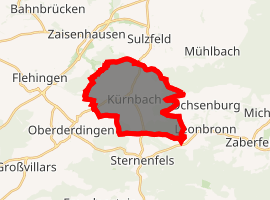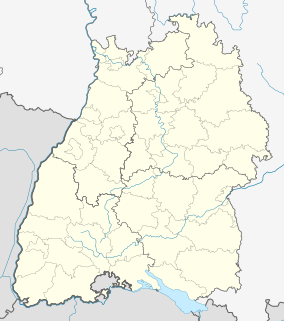Kürnbach
Kürnbach is a municipality in the district of Karlsruhe in northwestern Baden-Württemberg.
Kürnbach | |
|---|---|
 Coat of arms | |
Location of Kürnbach 
| |
 Kürnbach  Kürnbach | |
| Coordinates: 49°04′37″N 08°50′39″E | |
| Country | Germany |
| State | Baden-Württemberg |
| Admin. region | Karlsruhe |
| District | Karlsruhe |
| Government | |
| • Mayor | Armin Ebhart |
| Area | |
| • Total | 12.67 km2 (4.89 sq mi) |
| Elevation | 213 m (699 ft) |
| Population (2018-12-31)[1] | |
| • Total | 2,335 |
| • Density | 180/km2 (480/sq mi) |
| Time zone | CET/CEST (UTC+1/+2) |
| Postal codes | 75057 |
| Dialling codes | 07258 |
| Vehicle registration | KA |
| Website | www.kuernbach.de |
Geography
Geographical location
The historic wine village of Kürnbach, known as the Black Riesling village in the Kraichgau hill country, is one of the few communities in Germany with a history of shared governance. Kürnbach is located in the northwestern Stromberg-Heuchelberg Nature Park near Zabergäu in the valley Humsterbaches. The Humsterbach was dammed as a retention basin east of the village next to Schlosswiesensee. To the west, the landscape opens up to the typical cultivated hill country of Kraichgau, while to the east a large contiguous forest area of Stromberg-Heuchelberg nature park begins.
Constituent communities
The municipality of Kürnbach include the Aussiedlerhöfe Heiligenäcker and the estate Humstermühle, Klostermühe and Rohrmühle.
History
Middle Ages
In the time of Charlemagne already stood a wooden church in Kürnbach, which was later replaced by a Romanesque stone building. The oldest surviving written tradition with reference to Kürnbach dates back to 1278. It is a goods list of the monastery of Weissenburg. Based on this document you can see that Kürnbach was already since about 990 in the possession of the Benedictine monastery. About 100 years later, the name of a noble family of Kürnbach appears for the first time. In 1543 Kürnbach got the market right.
Condominium
“KÜRNBACH – this market town of two states, divided into Hesse and Baden…” said the homeland poet Samuel Friedrich Sauter. With the history of the condominium Kürnbach has to offer a constitutional rarity. Kürnbach belonged to two-thirds of the county Hesse and one-third to the Duchy of Württemberg and from 1810 to the Grand Duchy of Baden. The village was divided into 2 states but had no border. The nationality was assigned to each inhabited houses, which means that the Citizenship changed with the purchase of a particular house. Around 300, two third of Kürnbach became a fief of the Counts of Katzenlnbogen. The other part of the village pledges Engelhard von Liebenstein 1320 to the Duchy of Württemberg. In 1479, the Counts of Katzenlnbogen were inherited by the Landgraves of Hesse. Kürnbach now belonged to two-thirds of the county Hesse and one-third to the Duchy of Württemberg and thus formed a condominium. Individual cultivated land was assigned to one of the two dominions but could change these as well. Therefore, there were three different administrations, pertaining respectively to Hesse, Württemberg (later Baden) and the condominium. After the division of land, the Hessian proportion came to the county Hesse-Darmstadt. With the peace of Schönbrunn the Württemberg proportion came to the Grand Duchy of Baden. Kürnbach formed an enclave in Baden state territory and bordered the rest of the Kingdom of Württemberg.
In 1835, a separate municipal code was issued. There were two mayors elected for a six-year term and each mayor chairing the council for three years. Each mayor ran his own registry office. Three municipal calculations had to be conducted: one Baden, one Hessian and one condominium with two different financial years on two different legal bases. The residents of Kürnbach profited from this because they paid less than “true” Badeners or Hesse. In addition, Hesse has consistently resisted during the 19th century cede his rights in Kürnbach to Baden. After the founding of the Reich in 1871 and the subsequent legal unification but the constitutional construct Kürnbach appeared more abstruse and the privileges of the “tax haven” were hardly to be represented against the other citizen. Despite the Kürnbacher's resistance, a state treaty between the two states was concluded on May 11, 1903 in Heidelberg. Kürnbach thus belonged to the Grand Duchy of Baden from 1 January 1905. In exchange, the Grand Duchy of Hesse received the enclave Michelbuch and almost 300 ha of Baden forest near Heddesbach.
Emigration to America
In the middle of the 19th century the rate of poverty was particularly high. In addition to bad harvest, there were many wine-losing years which led to a wave of emigration to America. Next to economic reasons there were also political. The most famous Kürnbacher was John Adam Treutlen who later became governor of Georgia. Other well-known emigrants are for example Blickensdörfer, Pfeiffer, has, Krämer and Weisert.
20th century
The restoration of the village began 1965. From this time Kürnbach belonged completely first to the district office Bretten, then to the district Sinsheim which was dissolved in 1973. Since then the place is assigned to the district of Karlsruhe.
Religion
Since the reformation Kürnbach is predominantly evangelical. In addition to the parish of the regional church there is also a Protestant-Methodist and a new Apostolic congregation. Roman Catholic faithful are cared by the community in Oberderdingen-Flehingen. Every religious community has its own church in the village.
Population development
• 1939 1.145 inhabitants
• 1950 1.665 inhabitants
• 1970 2.130 inhabitants
• 2010 2.277 inhabitants
• 2015 2.330 inhabitants
Politic
Mayor
• 1905–1919 Theodor Henninger
• 1919–1933 Karl Heinrich Hauser
• 1934–1945 Otto Hauffe
• 1945–1947 Karl Heinrich Hauser
• 1947–1964 August Büchele
• 1964–1984 Kurt Böckle
• 1984–2016 Karl-Heinz Hauser
• since 2016 Armin Ebhart
Regional council
After the local election 2014 there are four voter communities represented in the municipal council.
• FWV (35,3 %): four seats
• Handel, Handwerk und Gewerbe (HHG) (25,1 %): three seats
• Liste 4 (26,0 %): three seats
• Liste 90 (13,7 %): two seats
Blazon
The municipality Kürnbach leads as a coat of arms a standing in red silver eagle claw.
Partnership
Since 1983 Kürnbach has a partnership with the community Ziersdorf in Austria.
Economy and Infrastructure
Education
Kürnbach has its own elementary school and two kindergartens.
Culture and sights
Historic center
In the historic center you will find numerous half-timbered buildings of different eras such as the Hessen-Kelter, the Deutschherrenhaus, which was once a supply situation for the Teutonic Order, or the moated castle, which was built from a historic moated castle. In 1266 the castle was owned by the Lords of Liebenstein. From 1380 were knights of Balzhofen and after the knights of Sternenfels on castle Kürnbach. Until the mid-19th century the castle was a family property of the Grand Dukes of Hesse, then the property was privately owned. The castle is surrounded by greenery and at the former Upper Gate houses there is the old town hall and the old schoolhouse.
Church
In Kürnbach stood around 800 a wooden church which was later replaced by a Romanesque stone building and is now known as the Protestant Michael's Church. It received the present look through the reconstruction (1721 – 1725) after the building was destroyed in the Thirty Years ‘War. Among the art treasures of the church include the choir vault; the crucifix from the 16th century, which is created with sandstone; five-meter-high Renaissance tomb for Bernhard von Sternenfels and his wife Maria Agatha von Weitershausen and the organ, which was built in 1834 by the Heidelberg organ builder Wilhelm Jacob Overmann.
Museums
The Historic Actien Museum, house in a historic peasant estate near the Upper Gate, has been showing historic securities since 1976.
Personalities
Honorary citizen
• Kurt Böckle (1922 – 1993); mayor from 1964 to 1984, honorary citizen to leave office
Other personalities
• Friederike Louise Löffler (1744 – 1805); Pharmacist´s daughter and well-known cookbook author, born in Kürnbach, mother of Henriette Löffler, also known as a cookbook author
• Friederike Hauffe (1801 – 1829); the "seer of Prevorst", lived from 1821 to 1826 in Kürnbach
• John A. Treutlen (1734 – 1782); American politician and from 1777 to 1782 Governor of Georgia, USA.
References
- "Bevölkerung nach Nationalität und Geschlecht am 31. Dezember 2018". Statistisches Landesamt Baden-Württemberg (in German). July 2019.